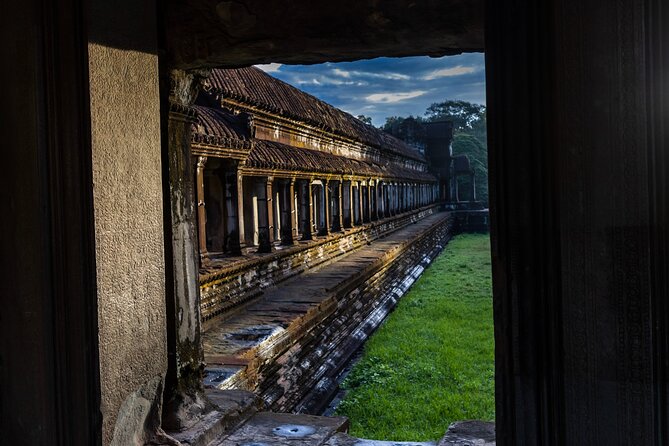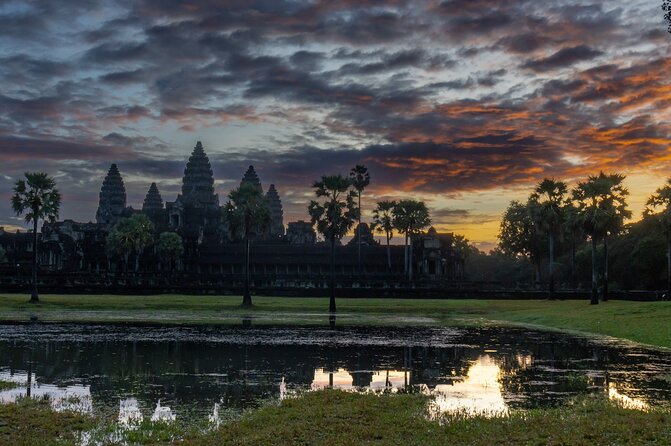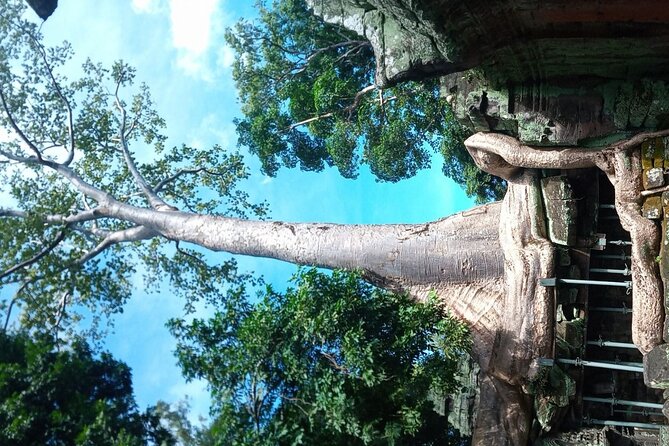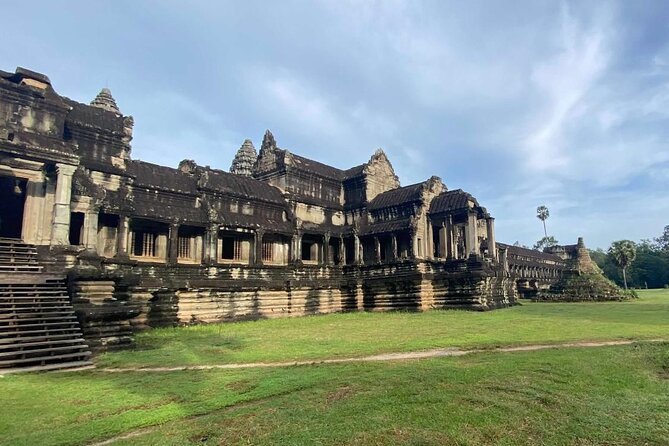Angkor Wat, a UNESCO World Heritage site in Cambodia, stands as a testament to the architectural genius of the ancient Khmer civilization. With its towering spires and intricate carvings, this 12th-century temple complex is a remarkable feat of engineering.
Not only is it a religious sanctuary dedicated to the Hindu god Vishnu, but it is also a masterpiece of art. Angkor Wat is believed to represent Mount Meru, the mythical abode of the gods.
Beyond its historical significance, visitors to Angkor Wat can enjoy its rich spirituality and explore the vast grounds. From the captivating sunrise to the serene atmosphere within its walls, Angkor Wat offers an unforgettable experience, allowing travelers to connect with the past and uncover its hidden wonders.
Good To Know

- Angkor Wat is the largest religious monument in the world and covers an area of over 400 acres.
- It was originally built as a Hindu temple but later transitioned into a Buddhist site, making it a place of worship and pilgrimage for both Hindus and Buddhists.
- The temple complex is adorned with stunning bas-reliefs depicting Hindu mythology and intricate carvings and sculptures that depict religious stories and deities.
- Angkor Wat is a major tourist attraction in Cambodia, generating revenue for the local economy and supporting local businesses and infrastructure development.
History and Architecture

Exploring the history and architecture of Angkor Wat, visitors are captivated by its grandeur and intricate design. The construction of Angkor Wat, which began in the 12th century, is a testament to the incredible engineering skills of the Khmer Empire.
The temple complex covers an area of over 400 acres and is surrounded by a moat, symbolizing the mythical Mount Meru, the abode of the gods. The main temple, dedicated to the Hindu god Vishnu, rises to a height of 213 feet and is adorned with stunning bas-reliefs depicting scenes from Hindu mythology.
Angkor Wat’s construction and design reflect the cultural importance of Hinduism in the Khmer Empire. Its intricate carvings and towering spires continue to inspire awe and admiration in visitors from around the world.
Find more activities and experiences we've covered in Siem Reap.
Religious Significance
Why is Angkor Wat considered a place of religious significance?
Angkor Wat holds immense religious significance due to its historical connection to Hinduism and Buddhism. Originally built as a Hindu temple dedicated to the god Vishnu, it later transitioned into a Buddhist site.
The temple complex served as a place of worship and pilgrimage for both Hindus and Buddhists, reflecting the religious practices of the Khmer Empire. The intricate carvings and sculptures found throughout Angkor Wat depict religious stories and deities, further emphasizing its spiritual importance.
Today, Angkor Wat continues to be a place of religious significance, attracting visitors from around the world who come to witness its beauty and experience the cultural impact it has had on the region.
Visitor Experience

Visitors to Angkor Wat can expect a captivating and immersive experience as they explore the ancient temple complex. With its breathtaking architecture, intricate carvings, and rich history, it’s no wonder that Angkor Wat is considered one of the world’s most remarkable archaeological sites.
Many visitors have expressed their awe and admiration for the grandeur of Angkor Wat, describing it as a truly awe-inspiring and unforgettable experience. The temple complex offers a unique opportunity to step back in time and marvel at the intricate craftsmanship of the Khmer Empire.
To enhance their visit, many travelers choose to hire tour guides who provide insightful commentary and share fascinating stories about the temple complex. These knowledgeable guides help visitors navigate the vast site and provide valuable context and information about the historical significance of Angkor Wat.
With their guidance, visitors can gain a deeper understanding and appreciation for this magnificent UNESCO World Heritage site.
Must-See Temples

One can’t miss out on visiting the must-see temples of Angkor Archaeological Park. These temples not only showcase the incredible architectural marvels of the ancient Khmer empire but also hold immense cultural and historical significance.
One of the most iconic temples is Angkor Wat, known for its grandeur and intricate carvings. It’s a prime example of temple restoration, as efforts have been made to preserve its original beauty.
Another must-see temple is Bayon, famous for its massive stone faces that exude a sense of mystery and wonder.
Angkor Thom, with its imposing gates and terraces, is also a sight to behold.
Lastly, the enchanting Ta Prohm, with trees growing out of its ruins, highlights the cultural impact and the harmony between nature and architecture.
Exploring these temples is like stepping back in time and immersing oneself in the rich history of the Khmer civilization.
Sunrise and Sunset Views
The sunrise and sunset views at Angkor Wat are a breathtaking sight to behold. As the sun rises or sets behind the magnificent temple, the sky is painted in hues of orange, pink, and gold, creating a stunning backdrop for this ancient wonder.
For photography enthusiasts, there are several spots within the temple complex that offer the best vantage points for capturing these magical moments. The reflection of the temple in the lotus pond, the silhouette of the intricate carvings against the colorful sky, and the panoramic views from the upper levels all make for incredible photographs.
Local legends also add to the allure of these views, with stories of gods and mythical creatures descending from the heavens during these times, lending an ethereal and mystical atmosphere to the experience.
- Siem Reap: Angkor Wat Sunrise Small-Group Guided Day Tour
- Siem Reap: Full Day Angkor Wat Temple Experience With Sunset
- Siem Reap Angkor Airport to Siem Reap City by Shuttle Bus
- Kulen Mountain: Small-Group Tour and Picnic Lunch
- Siem Reap: Phare, the Cambodian Circus Show Tickets
- Ticket for Angkor Balloon Ride.
Conservation Efforts
To ensure the preservation of Angkor Wat, conservation efforts are continuously undertaken by local authorities and organizations. Recognized as a UNESCO World Heritage Site, Angkor Wat is a significant cultural and historical landmark that requires special care and attention.
The conservation efforts focus on maintaining the structural integrity of the temple complex, protecting it from natural elements such as erosion and vegetation growth. The local authorities work closely with experts in the field to implement effective strategies for the conservation of the site. This includes regular inspections, restoration of damaged areas, and ongoing research to enhance understanding of the temple’s construction and materials.
Plus, efforts are made to raise awareness among visitors about the importance of responsible tourism and the role they play in preserving this magnificent monument for future generations to admire and appreciate.
Surrounding Attractions

Conservation efforts at Angkor Wat extend beyond the temple complex to encompass the preservation of the surrounding attractions. Visitors to Angkor Wat have the opportunity to explore not only the magnificent temple itself, but also the nearby attractions that showcase the rich history and culture of the region.
Here are three notable attractions in the vicinity:
Banteay Srei: Known as the ‘Citadel of Women,’ this temple is renowned for its intricate carvings and pink sandstone architecture.
Tonle Sap Lake: Located just a short distance from Angkor Wat, this expansive freshwater lake offers breathtaking views and the opportunity to experience local village life.
Siem Reap Night Market: After a day of exploring, visitors can indulge in the vibrant atmosphere of the night market, where they can shop for souvenirs and sample delicious local cuisine.
For those looking to stay in the area, there are plenty of nearby accommodations ranging from luxury resorts to budget-friendly guesthouses, ensuring that every traveler can find the perfect place to rest and rejuvenate after a day of exploration.
Tips for Visiting
When planning a visit to Angkor Wat, it’s important to keep in mind a few helpful tips.
Firstly, it’s best to visit during the early morning or late afternoon when the crowds are smaller and the lighting is more favorable for photography. The sunrise and sunset views are particularly breathtaking, so make sure to plan your visit accordingly.
Secondly, bring a good camera and consider using a tripod to capture the intricate details of the temple complex. Angkor Wat is a photographer’s paradise, so take your time to explore and experiment with different angles and compositions.
Lastly, don’t forget to respect the sacredness of the site by dressing appropriately and following any guidelines or rules set by the authorities.
Enjoy your visit to this magnificent wonder of the world!
Common Questions
How Long Does the Private Tour of Popular Temples in Angkor Archaeological Park Typically Last?
The private tour of popular temples in Angkor Archaeological Park typically lasts about 8 hours. The best time to visit is in the morning to avoid the crowds and make the most of the experience.
What Is the Cost of the Private Tour of Popular Temples in Angkor Archaeological Park?
The cost of the private tour of popular temples in Angkor Archaeological Park starts from £29.21. The duration of the tour typically lasts for a certain amount of time, allowing visitors to explore the magnificent temples.
Is Transportation Provided for Hotel Pickup in the Morning?
Yes, transportation is provided for hotel pickup in the morning. Guests can enjoy the convenience of being picked up from their hotel and taken to the popular temples in Angkor Archaeological Park. Alternatively, there may be other transportation options available.
Are There Any Restrictions or Dress Codes for Visiting the Temples?
There are certain restrictions and dress codes when visiting the temples. Visitors are required to dress modestly and cover their shoulders and knees. Plus, there may be restrictions on touching or climbing certain areas of the temples.
What Is the Cancellation Policy for the Private Tour of Popular Temples in Angkor Archaeological Park?
The cancellation policy for the private tour of popular temples in Angkor Archaeological Park is non-refundable and cannot be changed. It is important to note that the duration of the tour may vary depending on the specific itinerary.
The Sum Up
To sum it up, Angkor Wat is a truly magnificent and awe-inspiring temple complex that captivates visitors with its grandeur and rich history. Its intricate carvings, towering spires, and stunning bas-reliefs showcase the architectural brilliance of the ancient Khmer civilization.
As a UNESCO World Heritage site, it isn’t only a religious monument but also a masterpiece of art and engineering.
Exploring its vast grounds and experiencing the mesmerizing sunrise and peaceful ambience within its walls make for an unforgettable journey into the past.
More Tour Reviews in Siem Reap
Looking for something different? Other Siem Reap activities we've written about
- Siem Reap Angkor 4 Best of the Best Temples Tour
- 1 Day Sunrise & Temples Tour
- 25 Best Guided Tours In Siem Reap
- 16 Best Shopping Tours In Siem Reap
- 25 Best Boat Tours And Cruises In Siem Reap
- 25 Best Tours In Siem Reap
- 12 Best Motorbike And Scooter Rentals In Siem Reap
- 6 Best Massage And Relaxation Services In Siem Reap
- 16 Best Historical Tours In Siem Reap
- 25 Best Workshops And Classes In Siem Reap
- 20 Best 3 Day Tours In Siem Reap
- 20 Best Full-Day Tours In Siem Reap
